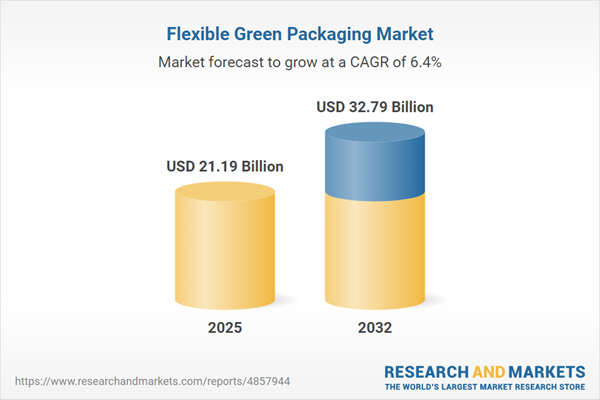Speak directly to the analyst to clarify any post sales queries you may have.
The flexible green packaging market is rapidly evolving as sustainability, regulatory compliance, and cost management become higher priorities for global supply chains and brands. This report delivers strategic insights senior leaders need to navigate, invest, and innovate in flexible green packaging solutions that align with both business and environmental objectives.
Market Snapshot: Flexible Green Packaging Market Growth and Dynamics
The Flexible Green Packaging Market grew from USD 20.01 billion in 2024 to USD 21.19 billion in 2025. It is expected to continue growing at a CAGR of 6.36%, reaching USD 32.79 billion by 2032. Heightened climate imperatives, increasing consumer requirements for authentic sustainability, and shifting regulatory frameworks are influencing material innovation and operational priorities across regions.
Scope & Segmentation: Comprehensive Analysis of Flexible Green Packaging
- Material: Compostable, recyclable, reusable packaging materials supporting diverse end-of-life pathways.
- Packaging Form: Options include films (roll stock, sheets), pouches and bags (flat, gusseted, stand-up), sleeves, and wraps (cling wrap, shrink film).
- Structure: Multilayer (four-, three-, two-layer) and single-layer configurations to optimize performance and recycling capability.
- Application: Flexible packaging solutions for food and beverage, healthcare and pharmaceuticals, industrial, and personal care sectors.
- Sales Channel: Covers offline (direct sales, retail) and online retail distribution models.
- Regions: Detailed coverage of Americas (North America: United States, Canada, Mexico; Latin America: Brazil, Argentina, Chile, Colombia, Peru), Europe, Middle East & Africa (Europe: United Kingdom, Germany, France, Russia, Italy, Spain, Netherlands, Sweden, Poland, Switzerland; Middle East: United Arab Emirates, Saudi Arabia, Qatar, Turkey, Israel; Africa: South Africa, Nigeria, Egypt, Kenya), and Asia-Pacific (China, India, Japan, Australia, South Korea, Indonesia, Thailand, Malaysia, Singapore, Taiwan).
- Technology & Corporate Coverage: Reviews developments from leading companies including Amcor PLC, Ball Corporation, DuPont de Nemours, Mondi PLC, Huhtamäki Oyj, and others, with attention to applications of biopolymers, digital traceability, and recycling innovations.
Key Takeaways: Strategic Insights for Decision-Makers
- Flexible green packaging is central to corporate sustainability roadmaps, as businesses respond to escalating climate regulations and consumer demand for verifiable eco-friendly products.
- Rapid technological innovation—ranging from bio-based polymers to blockchain-enabled traceability—enables functional packaging to meet regulatory, operational, and brand objectives.
- Material and design choices are increasingly strategic, requiring alignment between recyclability, performance, and cost control amid rising policy mandates.
- Agile supply chain management and collaborative innovation with resin producers, recyclers, and retailers are critical for scaling circularity and responding to global trade dynamics.
- Brands expanding transparency—in labeling, sourcing, and end-of-life handling—strengthen market differentiation and customer loyalty while ensuring compliance.
Tariff Impact: Navigating United States Policy Shifts
The introduction of 2025 tariffs in the United States creates new sourcing challenges for flexible green packaging manufacturers. Producers are diversifying supplier relationships, exploring material alternatives, and investing in localized recycling to maintain cost-competitiveness and minimize tariff-related risks. This policy landscape will shape future procurement, supplier collaboration, and operations planning, requiring proactive adjustment from industry leaders.
Methodology & Data Sources
This research leverages a blend of primary interviews with senior executives across the value chain, technical assessments from independent labs, and a systematic review of global industry and policy documents. Scenario modeling and benchmarking ensure comprehensive, actionable insights on market dynamics and emerging technologies.
Why This Report Matters
- Empowers senior decision-makers to align investments with evolving compliance, consumer, and sustainability demands.
- Facilitates strategy development with segmentation-driven analysis, regional trends, and risk mitigation frameworks addressing policy and sourcing changes.
- Provides actionable guidance to accelerate innovation, partnership, and operational resilience in flexible green packaging.
Conclusion
With its strategic focus and evidence-driven insights, this report equips leaders to capture value and future-proof operations in the expanding flexible green packaging market. Informed action will position your organization to lead in sustainability, compliance, and competitive performance.
Additional Product Information:
- Purchase of this report includes 1 year online access with quarterly updates.
- This report can be updated on request. Please contact our Customer Experience team using the Ask a Question widget on our website.
Table of Contents
3. Executive Summary
4. Market Overview
7. Cumulative Impact of Artificial Intelligence 2025
Companies Mentioned
The companies profiled in this Flexible Green Packaging market report include:- Amcor PLC
- Ardagh Group S.A.
- Ball Corporation
- Botanical PaperWorks Inc.
- Crown Holdings, Inc.
- DS Smith Plc
- DuPont de Nemours, Inc.
- Elopak AS
- HI-CHEM Co., Ltd.
- Huhtamäki Oyj
- Mondi PLC
- Ranpak Holding Corp
- Rengo Co., Ltd.
- Sealed Air Corporation
- Smurfit Kappa Group
- Sonoco Products Company
- Southern Champion Tray
- Stora Enso Group
- Stora Enso Oyj
- Takigawa Corporation
- Tetra Pak International S.A.
- The Better Packaging Co
- The Riverside Company
- UFlex Limited
- WestRock Company
Table Information
| Report Attribute | Details |
|---|---|
| No. of Pages | 190 |
| Published | November 2025 |
| Forecast Period | 2025 - 2032 |
| Estimated Market Value ( USD | $ 21.19 Billion |
| Forecasted Market Value ( USD | $ 32.79 Billion |
| Compound Annual Growth Rate | 6.3% |
| Regions Covered | Global |
| No. of Companies Mentioned | 26 |









